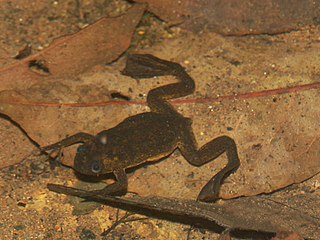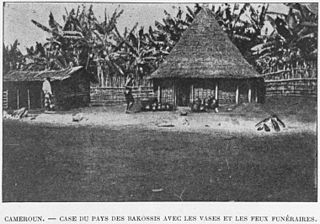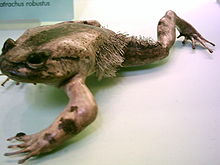
The Arthroleptidae are a family of frogs found in sub-Saharan Africa. This group includes African treefrogs in the genus Leptopelis along with the terrestrial breeding squeakers Arthroleptis, and several genera restricted to the Guinean forests of central and west Africa, such as the hairy frog (Trichobatrachus).

Astylosternus batesi is a species of frog in the family Arthroleptidae. It is found in Cameroon south of Sanaga River, Equatorial Guinea, Gabon, southwestern Central African Republic, the Republic of the Congo, and the extreme western Democratic Republic of the Congo (Mayombe). The specific name batesi honours George Latimer Bates, an American naturalist. However, its vernacular name is Benito River night frog, apparently in reference to its type locality, Benito River in Equatorial Guinea.

Astylosternus is a genus of frogs in the family Arthroleptidae. It contains 12 species found in an area spanning from Sierra Leone in West Africa to the Democratic Republic of Congo in Central Africa, with a gap in the region of Ghana.
Astylosternus fallax, also known as the Fopouanga night frog, is a species of frog in the family Arthroleptidae. It is endemic to south-western Cameroon where it is known only from between Yabassi and Nkongsamba, from Mount Yuhan in the Korup National Park, and from Mount Nta Ali in the Mamfe basin.
Astylosternus montanus, also known as the mountain night frog or montane night frog, is a species of frog in the family Arthroleptidae. It is found in the mountains of western Cameroon and into the Obudu Plateau in adjacent south-eastern Nigeria.
Astylosternus nganhanus is a species of frog in the family Arthroleptidae. It is endemic to Cameroon and known from Mount Nganha on the Adamawa Plateau; it is probably endemic to that area. Common name Nganha night frog has been coined for it. This poorly known species is only known from five specimens.

Astylosternus perreti, also known as Perret's night frog is a species of frog in the family Arthroleptidae. It is endemic to western Cameroon and known from Mount Manengouba and from parts of the Bamileke Highlands, at elevations of 1,200–1,400 m (3,900–4,600 ft) above sea level. It is one of the few species of African frogs to have claws, used on demand, when it feels threatened.
Astylosternus rheophilus is a species of frog in the family Arthroleptidae. It is endemic to western Cameroon. Common name Cameroon Range night frog has been coined for it. Two subspecies are recognized:
Astylosternus schioetzi is a species of frog in the family Arthroleptidae. It is endemic to south-western Cameroon and is only known from two areas near Edéa, Apouh and Koupongo, separated by the Sanaga River. The specific name schioetzi honours Arne Schiøtz, a Danish herpetologist who has worked extensively on African tree frogs. Common name Apouh night frog has been coined for this species.
Leptodactylodon bueanus is a species of frogs in the family Arthroleptidae. It is endemic to western Cameroon and known from the eastern slope of Mount Cameroon and from Bimbia Hill near Limbe. It was originally described as a subspecies of Leptodactylodon albiventris and is also similar to Leptodactylodon stevarti.
Afrixalus lacteus is a species of frog in the family Hyperoliidae. It is endemic to Cameroon and known from a few mountains in the western part of the country; specifically, it has been recorded from Mount Manengouba, Mount Nlonaka, and the southern Bamileke Highlands. Common name Cameroon banana frog has been coined for it. Prior to its description, it was confused with Afrixalus lindholmi.
Hyperolius dintelmanni is a species of frogs in the family Hyperoliidae. It is endemic to Cameroon and found in the montane southwestern part of the country. Specifically, it has been recorded from the Bakossi Mountains, including the Edib Hills and Mount Kupe. The specific name, dintelmanni, honors Mr. Horst Dintelmann from Germany in recognition of "his support of taxonomic research and forthcoming conservation projects in Cameroon".
Hyperolius kuligae is a species of frog in the family Hyperoliidae. It is found in southwestern Cameroon, Gabon, and Equatorial Guinea and eastward to the central Democratic Republic of the Congo; it probably occurs in northern Republic of the Congo and the Central African Republic too. It is also reported from Uganda, but the status of this population is unclear. The specific name kuligae honours Paul Kuliga (1878–1948), a physician who joined an expedition to Cameroon in 1936. Common names Camp Kivu reed frog and Kuliga reed frog have been proposed for it.
Leptopelis nordequatorialis, also known as the West Cameroon forest treefrog, is a species of frog in the family Arthroleptidae. It is found in central and western Cameroon and eastern Nigeria. It is closely related to Leptopelis anchietae and Leptopelis oryi.

Phrynobatrachus calcaratus, the Boutry river frog or Peters' puddle frog, is a species of frog in the family Phrynobatrachidae. It is widely distributed in West Africa and Middle Africa. However, this nominal species is a species complex consisting of several species.

The Lake Oku clawed frog is a species of frog in the family Pipidae, endemic to Lake Oku, a small crater lake in northwest Cameroon. It is a small, dark-coloured, fully aquatic frog with a length of 28 to 36 mm, males being slightly smaller than females. The International Union for Conservation of Nature has rated this frog as "critically endangered" on the basis of its small area of occurrence at a single location, and the possibility that introduction of non-native fish into the lake could cause the frog to be wiped out.
Ptychadena perreti is a species of frog in the family Ptychadenidae. It is found in Cameroon, Gabon, Republic of the Congo, southwestern Central African Republic and northern Democratic Republic of the Congo. It might occur in the Cabinda enclave of Angola and mainland Equatorial Guinea. Common name Perret's grassland frog has been coined for it.

The Bakossi people are a Bantu ethnic group that live on the western and eastern slopes of Mount Mwanenguba and Mount Kupe in the Bakossi Mountains of Cameroon. They number about 200,000, mostly engaged in subsistence farming but also producing some coffee and cocoa.

Leptodactylus fallax, commonly known as the mountain chicken or giant ditch frog, is a critically endangered species of frog that is native to the Caribbean islands of Dominica and Montserrat. The population declined by at least 80% from 1995 to 2004, with further significant declines later. A tiny wild population remains on Dominica where there are efforts to preserve it, but few or none survive in the wild on Montserrat and its survival now relies on a captive breeding project involving several zoos. The initial decline was linked to hunting for human consumption, along with habitat loss and natural disasters, but the most serious threat now appears to be the fungal disease chytridiomycosis, which was the primary cause of the most recent rapid decline. On Montserrat it is known as the mountain chicken, while on Dominica it is known as the crapaud.

Ecnomiohyla rabborum, commonly known as Rabbs' fringe-limbed treefrog, is a possibly extinct species of frog in the family Hylidae. They were relatively large frogs that inhabited the forest canopies of central Panama. Like other members of the genus Ecnomiohyla, they were capable of gliding by spreading their enormous and fully webbed hands and feet during descent. The males of the species were highly territorial and would guard water-filled tree holes used for breeding. They were also the ones responsible for guarding and caring for the young, including providing food. They were the only known species of frog where the tadpoles derived nutrition by feeding on the skin cells of their fathers.










